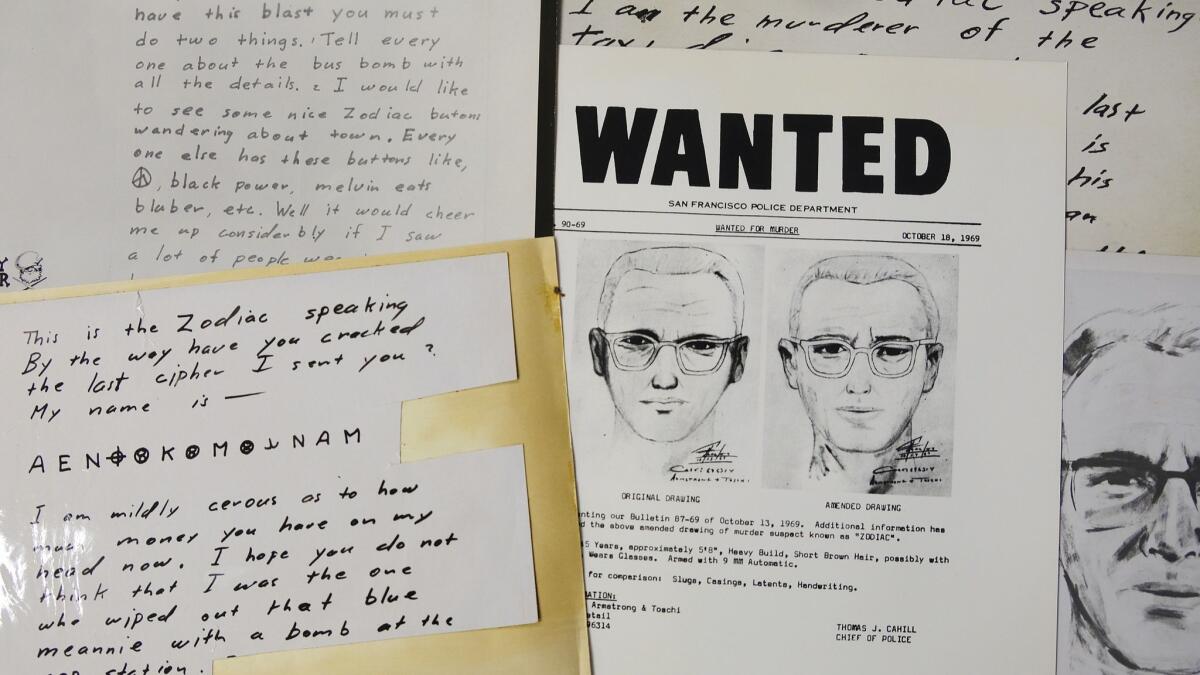DNA match sought to Zodiac Killer after break in Golden State Killer case

- Share via
Reporting from San Francisco — Northern California detectives still trying to identify the infamous Zodiac Killer, who targeted victims in the late 1960s and taunted investigators with letters, say they hope to try the same DNA tracing technology recently used to arrest a suspect in another string of cold-case serial slayings — those blamed on the Golden State Killer.
But first they have to get a better DNA profile.
Several months ago, the Vallejo Police Department sent two letters written by the Zodiac Killer to a private lab in hopes of finding his DNA on the back of the stamps or envelope flaps that may have been licked. They are expecting results soon.
“They were confident they would be able to get something off it,” Vallejo police Det. Terry Poyser told the Sacramento Bee.
Poyser said he hopes a full DNA profile will be found that will enable detectives to try the same DNA sleuthing techniques that were used to arrest Joseph James DeAngelo Jr. last month. Authorities suspect he committed at least 12 slayings and 46 rapes in California between 1976 and 1986.
Investigators uploaded DNA collected at one of the crime scenes to an open-source genealogical website and found a partial match to a distant relative of DeAngelo’s. From there, they constructed a family tree dating back several generations before they zeroed in on DeAngelo.
Some privacy advocates say they are concerned with the process and worry about future abuses, but detectives investigating the Zodiac Killer say they hope the technique will help solve one of the most vexing cold cases in the country.
“That’s a great idea,” said Gary Harmor, founder and director of the Serological Research Institute, a private DNA lab. “I think we’ll see more investigations use this technique.”
Detectives in Southern California are testing DNA collected from a double-killing and rape to see if they can be tied to DeAngelo. Another man, Craig Coley, was recently cleared of those crimes after spending 38 years in prison in the slaying of a 24-year-old college student and her 4-year-old son in 1978.
The Zodiac Killer fatally stabbed or shot to death five people in Northern California in 1968 and 1969, then sent taunting letters and cryptograms to the police and newspapers. The Vallejo police are the lead investigators because the first two victims were killed there.
The suspect was dubbed the Zodiac Killer because some of the cryptograms included astrological symbols and references.
Various pieces of evidence, including a rope used to tie a victim as well as the letters, have been tested unsuccessfully for the killer’s DNA profile. Poyser said recent advances in DNA testing prompted investigators to seek a match on two of the killer’s letters.
Vallejo Mayor Bob Sampayan said the samples were sent to the lab as a matter of routine. Sampayan, a former homicide detective, said police submit samples every couple of years in hopes that advances in DNA testing will finally yield a profile detectives can use.
“It was coincidental,” Sampayan said of the new DNA test occurring at the same time as the breakthrough in the Golden State Killer case.
“There will come a time when we get a match,” he said.
The 2007 movie “Zodiac,” starring Jake Gyllenhaal and Robert Downey Jr., renewed widespread interest in a case that has always had a cult following of amateur detectives and cryptographers who sought to crack the killer’s code.
One of those amateur sleuths, Tom Voigt, said the key to solving the Zodiac killings is mimicking the Golden State Killer investigation, which included forming a full-time task force dedicated to the case and exploiting publicly accessible DNA databases.
Voigt said the Zodiac case was being investigated part time by a Police Department in a city that filed for municipal bankruptcy.
“There’s a formula to follow,” Voigt said. “And it’s to simply copy what happened to the Golden State Killer.”
More to Read
Sign up for Essential California
The most important California stories and recommendations in your inbox every morning.
You may occasionally receive promotional content from the Los Angeles Times.










